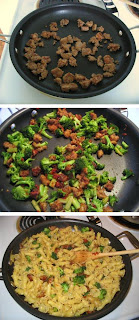
If I could pick an official pasta for Spring, it would be Campanelle. Shaped like a dainty bell or flower, campanelle is Italian for “little bell” or it is also called gigli meaning “lilies." Not only is it pretty but it's a very functional pasta because the funnel-like shape is perfect for holding a little smidgen of sauce. I'm sure it'd also be lovely for pasta salads because it is just too cute!
I love spontaneously created dishes that turn out surprisingly well. Last night the original plan was to eat leftovers but Steven announced that he wanted pasta. Being the accommodating cook that I am, I poked around in the fridge and we tried to pull together a decent pasta dish. The other day he mentioned how he really liked the sun-dried tomatoes we had, so I got those out of the fridge. Then I gathered a crown of broccoli along with the remainder of some roasted garlic. I dug out some Italian sausages from the freezer and defrosted two. What started out as a random hodgepodge of casually thrown together ingredients transformed into a delicious pasta dish.
I added just a tiny bit of balsamic vinegar at the end to brighten up the flavors and it worked really well. Fresh herbs would have made this dish even better but the Italian herb blend is always a staple in my pantry.
Campanelle with Italian Sausage, Sun-dried Tomatoes, and Broccoli
2 Italian sausages
1 broccoli crown, cut into small florets (about 2 cups)
2 Tbsp sun-dried tomatoes, rinsed of excess oil and minced
3 cloves roasted garlic, pureed or minced (can use regular garlic)
2 Tbsp extra virgin olive oil
1/4 tsp Italian herb blend (fresh herbs would be better)
salt and pepper
1 tsp balsamic vinegar
1/2 C grated Parmesan
8 oz. campanelle
Cut the broccoli crown into small bite size florets. The remaining stem pieces can be cut into small matchstick pieces and cooked with the florets. I like to peel off the outer fibrous layer.
 Remove the Italian sausage from the casing. Heat a skillet over medium high heat and brown the sausages, breaking the sausages into small bite size pieces. Lower the heat to medium and fully cook the sausage pieces. Remove and drain on a paper towel lined plate.
Remove the Italian sausage from the casing. Heat a skillet over medium high heat and brown the sausages, breaking the sausages into small bite size pieces. Lower the heat to medium and fully cook the sausage pieces. Remove and drain on a paper towel lined plate. Meanwhile, boil a pot of water, and cook campanelle to al dente. Drain when finished.
Wipe the skillet clean, return to stovetop over medium heat, and add 2 Tbsp of extra virgin olive oil. Add broccoli florets, sun-dried tomatoes, roasted garlic, herbs, salt and pepper and saute for about 1 minute. Then add Italian sausage and a tablespoon of water and cook until broccoli is at desired tenderness. Add drained pasta and toss everything together. If the pasta looks too dry add a bit of water, about 1 Tbsp, to loosen it up.
Off heat, drizzle the balsamic vinegar over the pasta and toss to distribute evenly. Add half of the grated parmesan to mix into the pasta then use the remainder to top the pasta.
Serves 2
Links:

This will be my entry for Presto Pasta Night. Be sure to check out this week's roundup on Friday.

























